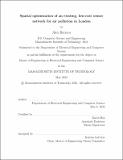Spatial optimization of an existing, low-cost sensor network for air pollution in London
Author(s)
Herrera, Alex
DownloadThesis PDF (2.018Mb)
Advisor
Hsu, David
Terms of use
Metadata
Show full item recordAbstract
Air pollution sensors are rapidly decreasing in cost and can provide measurements with higher spatial and temporal resolution. In this paper we combine two different Gaussian process methods to optimize spatially an existing low-cost sensor network for air pollution in London. We demonstrate the practical utility of these combined algorithms using a cross-validation approach, applied to air pollution data obtained from 75 sensors within the London Air Quality Network (LAQN) in 2011. The analysis steps were as follows. First, based on a training subset of the original data, we trained a spatio-temporal variational Gaussian process model to quantify the uncertainty within the area of London for a year at daily intervals. A second Gaussian process algorithm was then used to optimize sensor placements by maximizing mutual information to recommend relocating a subset of the existing sensors. Evaluating a second training subset of the original data, as if sensors were relocated to the new recommended locations, we find (on average) that the second model reflecting our new recommended locations increases the mutual information across the area of London by 27.3% while maintaining the same performance on prediction root mean square error within a third subset of the original data (the validation set). We then apply this procedure to a model trained on all 75 sensors to generate an optimized redistribution of the LAQN air pollution sensors. We conclude with ideas for further extensions of this work.
Date issued
2022-05Department
Massachusetts Institute of Technology. Department of Electrical Engineering and Computer SciencePublisher
Massachusetts Institute of Technology